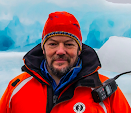Vanished Beyond the Map
The Mystery of Lost Explorer Hubert Darrell
By Adam Shoalts
Allen Lane, An Imprint of Penguin Canada, 2025
Toronto, Ontario, Canada
$37.00CAN/$27.00 US
Reviewed by Lawrence Millman
With respect to the Northwest Passage, the North Pole, or a celebrated geographic site, Arctic explorers have a tendency to be obsessively goal-oriented. Consider Commodore Robert Peary’s statement of “Mine at last!” upon attaining (or not attaining) the North Pole. These words suggest that he had engineered a hostile corporate takeover on that part of the earth’s geography.
Hubert Darrell was a quite different sort of explorer. Born in England in 1874, he emigrated to Canada, specifically Manitoba, but quickly realized he was cut out for a landscape much less visited than the Great Plains. So he headed up to the Arctic. and over a relatively short period of time became a veritable Renaissance man — now a trapper, now a prospector, now a guide for the mounties, now a guide for fellow explorer David Hanbury, now a trailblazer, and now a mapmaker. Even so, a good many readers of this review won’t have heard of him.
Unlike Peary, Darrell was not a fellow who tooted his own horn. Whatever he accomplished he shared primarily with himself, writing undramatic descriptions of wherever he happened to travel or drawing maps in his notebooks. He wanted to experience the Arctic as intimately as possible, so he traveled by foot rather than dogsled whenever he could. For him, the less visited the locale, the better that locale; and during his various expeditions, his feet were probably the first human ones to press through the snow or step on patches of Calliergon giganteum, a common Arctic moss.
Darrell’s disappearance in 1910 hardly attracted much attention from the Canadian media. After all, he was not a celebrity like, for instance, Vilhjalmur Stefansson or Roald Amundsen, both of whom greatly admired him (Amundsen said that with a man like Darrell, “I could travel to the moon”). Nor was he an eccentric like John Hornby, the discovery of whose remains attracted a modest degree of media attention. Rather, he was a taciturn fellow for whom being off the proverbial Arctic map was akin to being in an earthly paradise…especially if he was accompanied by Inuit or Métis friends.
Canadian author-explorer Adam Shoalts has long been interested in Darrell and, particularly, in Darrell’s fate. How, Shoalts wonders, could such a supremely competent individual have disappeared without a trace? In Vanished Without Trace, Shoalts describes Darrell’s life in impressive detail. He also retraces several of Darrell’s Arctic expeditions, all the while deliberating on how the fellow might have met with such a seemingly unfortunate end.
Indeed, how might Darrell have bought the proverbial farm? There seemed to be no clear answer to this needle-in-the-haystack question, so Shoalts set out to retrace Darrell’s last expedition, which took place in the vicinity of the so-called Husky Lakes and not far from present-day Inuit hamlet of Tuktoyaktuk. In the end, he comes up with an admittedly haphazard answer. Concerning that answer, here’s a hint…or several hints: Darrell did not starve to death. Nor was he killed by an Inuk whom he had somehow managed to piss off. Nor was he attacked and eaten by a grizzly bear.
By the way, Shoalts bases his notion of Darrell’s presumed final campsite partially on the lichen growing on some cut stumps at the locale. “In the Arctic, it takes approximately fifty to a hundred years for lichens to establish themselves,” he writes. Not true! Different Arctic lichen species have different growth rates. Some, in fact, can start growing almost immediately after a bird or an animal deposits its fecal matter on a rock, since they utilize nitrogen as a jumpstart. This does not give the lie to Shoalts’ theory about Darrell’s final campsite so much as to make it seem even a bit more haphazard.
Let me conclude by saying that Vanished Beyond the Map is a more or less unputdownable book. It tends to be a bit putdownable on those occasions when Shoalts repeatedly sermonizes on what an admirable individual Darrell was. But, for the most part, the narrative is an altogether compelling blend of research, first-person drama, adventure, and Arctic history. As a result, Hubert Darrell is obscure no more.


